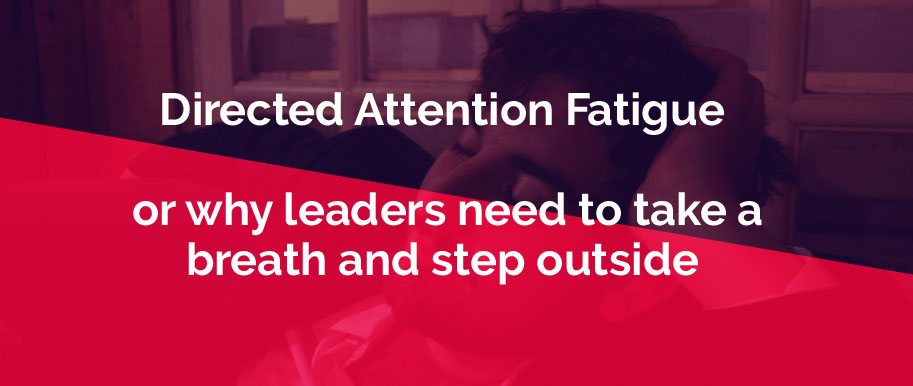Phone calls, meetings, deadlines for client work, organising suppliers – the list of daily distractions for business leaders to contend with is almost endless. And still, senior people are expected to make effective decisions despite being mentally burnt out. The name for this sounds complicated: Directed Attention Fatigue. Its implications for business are much more straightforward: poor decisions made against the clock or, worse still, avoided altogether.
Decision making in a culture of rush, rush, rush
Directed Attention Fatigue is when the brain becomes fatigued due to concentrating on one task while simultaneously inhibiting other distractions. In a workplace setting, this might look like trying to draw up a report, appease a client or lead a team while muting the above-mentioned distractions. When the brain is over-fatigued it can lead to mental burn out. Exhaustion, high stress levels and less than optimal function are the outcomes for the individual.
Busyness feels like productivity, yet can actually harm the person in question as well as their capacity to lead the business effectively in the long run. It’s a situation we see time and time again in the work we do here at Farscape.
As well as ramifications for the individual there are knock-on effects for the business. It’s important that business decisions, especially big ones, are given careful thought and not rushed. When fatigued or operating under strain, decisions are made in the heat of the moment, or at least without much time dedicated to thinking.
Fight or flight…or knee-jerk reaction
Quick decisions may be driven by fear. At some point or other we’ve likely all experienced thoughts such as: “I need to sort this now, or the department head is going to be furious…” or, “the client will leave…” or, “the key deliverable will be late.”
The action taken as a result of those thoughts is often hasty; the individual is responding to an immediate stressor and giving a knee-jerk response. They are operating in threat brain: the mind perceives a danger and the body and brain get ready for action, to run away or to fight. While this fight or flight response has served us well in our evolutionary development when faced with danger, it’s not so conducive to rational decision making in the workplace.
Farscape has successfully helped business leaders to change their behaviour and avoid reacting to events by encouraging them to take time for thinking. In the heat of the moment this could be as simple as taking a breath. Over an extended period, coaching is a helpful facility for taking time out, as it provides the space needed to consider a problem in an unhurried manner and from different angles.
Even more important than taking time to think with a coach is the environment in which the coaching happens. Somewhere away from the office, where the threat or stressor is far removed, allows the individual to think clearly. Clients can access ‘safe brain’, or the state of being that is responsible for normal body function, as opposed to fight or flight. They report that they feel calmer, able to make clearer decisions and be more effective as a result.
Time out in the face of a perceived threat feels counter-intuitive
This is a feeling many business leaders and senior executives experience, and with good reason. Back to our evolutionary history again, and of course it feels counter-intuitive to stand still and think when faced with danger. However, modern office life is not a life or death situation, although our response to stress is the same.
Why does pausing or time away really matter anyway?
Pausing means that the individual has time to establish what is driving their response – threat brain (fear) or safe brain (reason). Knowing what is driving their behaviour, they are then in a much better position to assess the situation and decide on a proportionate course of action.
The Time to Think approach developed by Nancy Kline provides a framework for leaders to monitor their thoughts and drivers. The approach encourages individuals not to hurry when giving a response, and to know that their turn will come to speak, meaning that situations can be approached with calmness and consideration.
In terms of outdoor coaching, we spend time with clients to find a suitable venue for them, tailoring it to their own preferences. Inspirational places that will encourage their mind to wander are the most effective. The natural environment doesn’t demand the same mental attention and the brain doesn’t have to inhibit distractions in the same way as in an office (S. Kaplan, 1995). Therefore, the individual can think freely without distraction or undue strain. And executives with clearer minds can make more astute business decisions – and that’s good for the whole company.
Fast-paced business demands fast-paced decisions, and constantly being faced with perceived threats and distractions can lead to mental burn out. The impacts can be felt far and wide, resulting in poor decisions and a company that suffers in the long run. Although it feels counter-intuitive, the best way to deal with mental burn out and a culture of rush, rush, rush is to take time out away from the office. It could give your leaders and business the competitive edge they are looking for.
